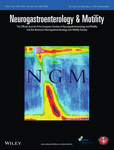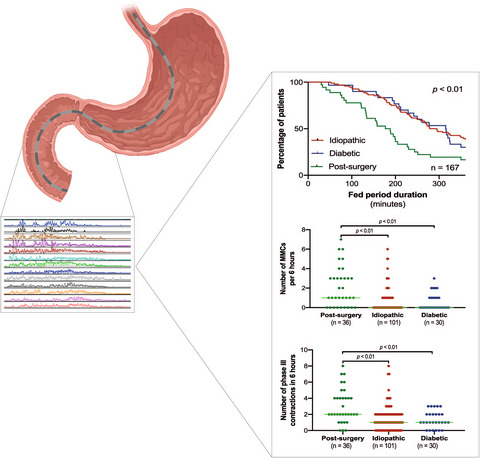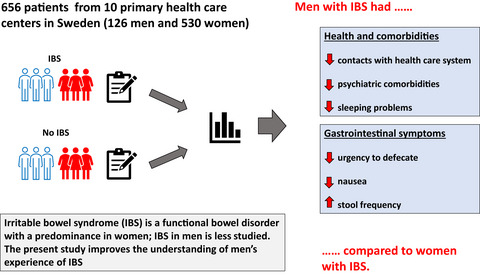Journal list menu
Export Citations
Download PDFs
ISSUE INFORMATION
MINI REVIEW
REVIEW
Role of the duodenal microbiota in functional dyspepsia
- First Published: 11 April 2022
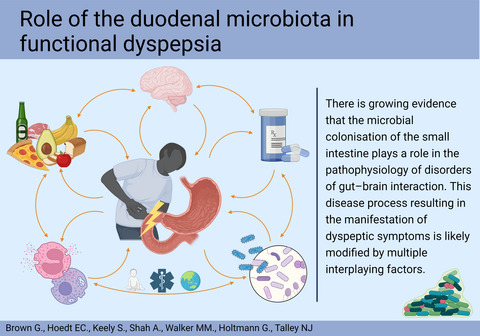
There is accumulating evidence that microbial colonization of the small intestine plays a role in the pathophysiology of disorders of gut–brain interaction. Functional dyspepsia is characterised in a major subset by low grade duodenal inflammation (eosinophils and mast cells), duodenal dysbiosis and altered mucosal barrier dysfunction. While low-grade inflammation might be the consequence of microbial dysbiosis, the inflammation may play a key role in sensory dysfunction. This disease process resulting in the manifestation of dyspeptic symptoms is likely modified by environmental factors most notably dietary factors or medications.
CLINICAL REVIEW
Normative values for esophageal functional lumen imaging probe measurements: A meta-analysis
- First Published: 05 June 2022

A meta-analysis of clinical studies describing Endoflip™ use for measurements of esophagogastric junction distensibility index (EGJ-DI) in healthy subjects reveals that only 5.4% of subjects have an EGJ-DI of 2 mm2/mmHg or lower, values below it can be considered abnormal. The clinical use of an upper limit for normality of EGJ-DI seems questionable.
ORIGINAL ARTICLES
Transvaginal rectocoele repair for the surgical treatment of a “symptomatic” rectocoele when conservative measures fail: A 12 year experience of 215 patients
- First Published: 05 March 2022
Latent class analysis does not support the existence of Rome IV functional bowel disorders as discrete entities
- First Published: 09 May 2022
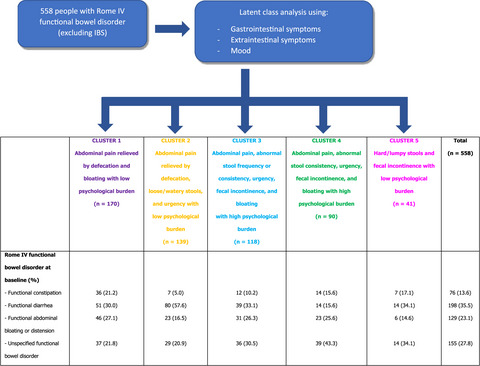
Among 558 people with a Rome IV functional bowel disorder, excluding IBS, latent class analysis identified five unique clusters characterized by a profile of gastrointestinal symptoms, extra-intestinal symptoms, and mood. However, correlation between these clusters and the Rome IV functional bowel disorder diagnoses was poor, and 75% of people were classified as having mild IBS using our previous IBS-derived model. The functional bowel disorders may be better characterized as a spectrum of IBS rather than separate disorders.
Antroduodenal motility recording identifies characteristic patterns in gastroparesis related to underlying etiology
- First Published: 09 May 2022
TECHNICAL NOTE
Automated extraction of anorectal pressures from high-resolution manometry reports
- First Published: 20 May 2022

During high-resolution anorectal manometry (HR_ARM), the raw data are converted into software-derived summary variables (e.g., rectoanal gradient during evacuation) that capture only a snapshot of the collected data. Computing different, more useful indices from the raw data requires time-consuming extraction of raw data from the program. We devised a reverse engineering method to compute anorectal pressures from pressure topography images in HR_ARM reports. Confirming the accuracy of this method, these pressures were significantly correlated with software-generated values. This method can be harnessed to compile large HR_ARM datasets across centers and to uncover newer, potentially more useful parameters.
ORIGINAL ARTICLES
Overlaps with bladder pain syndrome and irritable bowel syndrome are associated with higher symptom burden and reduced quality of life in functional dyspepsia
- First Published: 24 May 2022
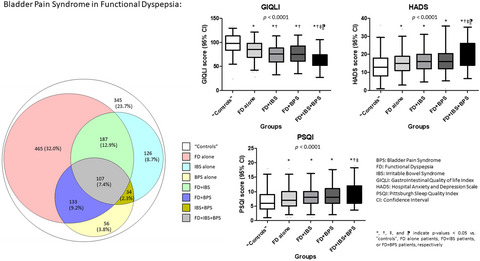
Bladder pain syndrome is present in 26.9% of functional dyspepsia patients and is associated with higher gastrointestinal, psychological distresses and sleep symptom burdens, and with reduced quality of life. We recommend to systematically assess the presence of bladder pain syndrome in patients with functional dyspepsia.
Effect of hiatus hernia on reflux patterns and mucosal integrity in patients with non-erosive reflux disease
- First Published: 20 May 2022
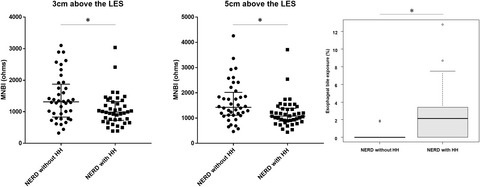
In patients with similar acid burden and similar motor function, the presence of a hiatus hernia, less non-acid reflux and lower post-reflux swallow-induced peristaltic wave index led to greater impairment of distal esophageal mucosal integrity compared with no hernia. HH impairs distal esophageal mucosal integrity possibly through excessive bile reflux.
Gastroenterology Trainees’ Attitudes and Knowledge towards Patients with Disorders of Gut-Brain Interaction
- First Published: 24 May 2022
TECHNICAL NOTE
An automated artifact detection and rejection system for body surface gastric mapping
- First Published: 14 June 2022
ORIGINAL ARTICLES
Symptoms and health experience in irritable bowel syndrome with focus on men
- First Published: 08 September 2022
Exploring the pathophysiology of LARS after low anterior resection for rectal cancer with high-resolution colon manometry
- First Published: 22 July 2022
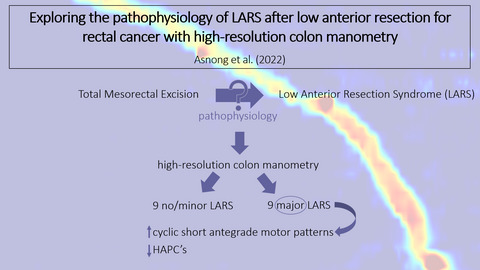
The occurrence of more cyclic short antegrade motor patterns and less HAPC's (from the proximal to the mid-colon) is more prevalent in patients with major LARS. These findings help to understand the differences in pathophysiology in patients developing major versus no/minor bowel complaints after TME for rectal cancer.
A prospective study of intrapyloric botulinum toxin and EndoFLIP in children with nausea and vomiting
- First Published: 10 July 2022
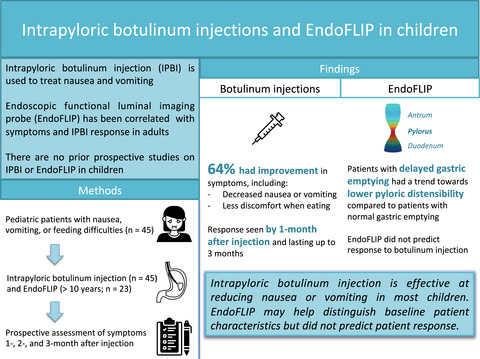
In this first prospective pediatric study of intrapyloric botulinum injections, we found improvements in nausea and vomiting in 64% of patients. Pyloric EndoFLIP was feasible in children as young as 11 years, and there was a trend towards lower pyloric distensibility associated with delayed gastric emptying.
Virtual Tai Chi program for patients with irritable bowel syndrome with constipation: Proof-of-concept feasibility trial
- First Published: 14 July 2022
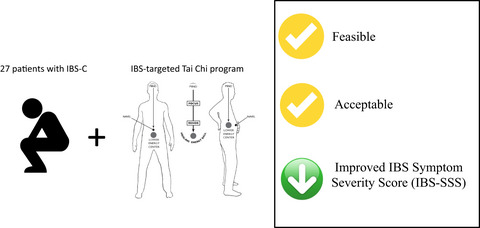
In a proof-of-concept trial of 27 patients enrolled in a virtual Tai Chi program designed specifically for irritable bowel syndrome with constipation delivered over 7 weeks, we demonstrated moderate to excellent feasibility with significant improvement in IBS Symptom Severity Scores (IBS-SSS).
Content available: Author Interview and Audio Recording
Long-lasting visceral hypersensitivity in a model of DSS-induced colitis in rats
- First Published: 05 August 2022
The effects of loperamide on excitatory and inhibitory neuromuscular function in the human colon
- First Published: 21 August 2022

Loperamide had no effect on isolated excitatory neuromuscular action in specimens of human colonic circular muscle (left). In preparations with isolated inhibitory neuromuscular action (right), loperamide reduced isometric relaxation during electrical field stimulation. Naloxone, added after loperamide, further reduced the isometric relaxation.
LETTERS TO THE EDITOR
Technical advances allow in-depth understanding of the gut–brain interaction—yet important caveats remain
- First Published: 09 August 2022
Response to “Technical advances allow in-depth understanding of the gut-brain interaction – yet important caveats remain”
- First Published: 14 September 2022




